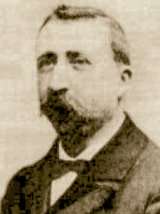Édouard Goursat
| Édouard Goursat | |
|---|---|
|
Edouard Goursat | |
| Born |
21 May 1858 Lanzac, Lot |
| Died |
25 November 1936 (aged 78) Paris |
| Nationality | French |
| Fields | Mathematics |
| Institutions | University of Paris |
| Alma mater | École Normale Supérieure |
| Doctoral advisor | Jean Gaston Darboux |
| Doctoral students |
Georges Darmois Dumitru Ionescu |
| Known for | Goursat tetrahedron, Cauchy–Goursat theorem, Goursat's lemma |
Édouard Jean-Baptiste Goursat (21 May 1858 – 25 November 1936) was a French mathematician, now remembered principally as an expositor for his Cours d'analyse mathématique, which appeared in the first decade of the twentieth century. It set a standard for the high-level teaching of mathematical analysis, especially complex analysis. This text was reviewed by William Fogg Osgood for the Bulletin of the American Mathematical Society.[1][2] This led to its translation in English by Earle Raymond Hedrick published by Ginn and Company. Goursat also published texts on partial differential equations and hypergeometric series.
Life
Edouard Goursat was born in Lanzac, Lot. He was a graduate of the École Normale Supérieure, where he later taught and developed his Cours. At that time the topological foundations of complex analysis were still not clarified, with the Jordan curve theorem considered a challenge to mathematical rigour (as it would remain until L. E. J. Brouwer took in hand the approach from combinatorial topology). Goursat’s work was considered by his contemporaries, including G. H. Hardy, to be exemplary in facing up to the difficulties inherent in stating the fundamental Cauchy integral theorem properly. For that reason it is sometimes called the Cauchy–Goursat theorem.
Work
Goursat was the first to note that the generalized Stokes theorem can be written in the simple form
where is a p-form in n-space and S is the p-dimensional boundary of the (p + 1)-dimensional region T. Goursat also used differential forms to state the Poincaré lemma and its converse, namely, that if is a p-form, then if and only if there is a (p − 1)-form with . However Goursat did not notice that the "only if" part of the result depends on the domain of and is not true in general. E. Cartan himself in 1922 gave a counterexample, which provided one of the impulses in the next decade for the development of the De Rham cohomology of a differential manifold.
Books by Edouard Goursat
- A Course In Mathematical Analysis Vol I Translated by O. Dunkel and E. R. Hedrick (Ginn and Company, 1904)
- A Course In Mathematical Analysis Vol II, part I Translated by O. Dunkel and E. R. Hedrick (Ginn and Company, 1916) (Complex analysis)
- A Course In Mathematical Analysis Vol II Part II Translated by O. Dunkel and E. R. Hedrick (Ginn and Company, 1917) (Differential Equations)
- Leçons sur l'intégration des équations aux dérivées partielles du premier ordre (Hermann, Paris, 1891)[3]
- Leçons sur l'intégration des équations aux dérivées partielles du second ordre, à deux variables indépendantes Tome 1 (Hermann, Paris 1896–1898)[3]
- Leçons sur l'intégration des équations aux dérivées partielles du second ordre, à deux variables indépendantes Tome 2 (Hermann, Paris 1896–1898)[3]
- Leçons sur les séries hypergéométriques et sur quelques fonctions qui s'y rattachent (Hermann, Paris, 1936–1939)[4]
- Le problème de Bäcklund (Gauthier-Villars, Paris, 1925)
- Leçons sur le problème de Pfaff (Hermann,Paris, 1922)[5]
- Théorie des fonctions algébriques et de leurs intégrales : étude des fonctions analytiques sur une surface de Riemann with Paul Appell (Gauthier-Villars, Paris, 1895)[6]
- Théorie des fonctions algébriques d'une variable et des transcendantes qui s'y rattachent Tome II, Fonctions automorphes with Paul Appell (Gauthier-Villars, 1930)
See also
- Goursat problem
- Goursat tetrahedron
- Goursat's lemma
- Goursat's theorem (Complex analysis)
References
- ↑ Osgood, W. F. (1903). "Review: Cours d'analyse mathématique. Tome I.". Bull. Amer. Math. Soc. 9 (10): 547–555. doi:10.1090/s0002-9904-1903-01028-3.
- ↑ Osgood, W. F. (1908). "Review: Cours d'analyse mathématique. Tome II.". Bull. Amer. Math. Soc. 15 (3): 120–126. doi:10.1090/s0002-9904-1908-01704-x.
- 1 2 3 Lovett, Edgar Odell (1898). "Review: Goursat's Partial Differential Equations". Bull. Amer. Math. Soc. 4 (9): 452–487. doi:10.1090/S0002-9904-1898-00540-2.
- ↑ Szegő, G. (1938). "Review: Leçons sur les séries hypergéométriques et sur quelques fonctions qui s'y rattachent by É. Goursat" (PDF). Bull. Amer. Math. Soc. 44 (1, Part 1): 16–17. doi:10.1090/s0002-9904-1938-06652-9.
- ↑ Dresden, Arnold (1924). "Review: Leçons sur le problème de Pfaff". Bull. Amer. Math. Soc. 30 (7): 359–362. doi:10.1090/s0002-9904-1924-03903-2.
- ↑ Osgood, W. F. (1896). "Review: Théorie des fonctions algébriques et de leurs intégrales, by P. Appell and É. Goursat". Bull. Amer. Math. Soc. 2 (10): 317–327. doi:10.1090/s0002-9904-1896-00353-0.
- Katz, Victor (2009). A History of Mathematics: An introduction (3rd ed.). Boston: Addison-Wesley. ISBN 978-0-321-38700-4.
External links
- O'Connor, John J.; Robertson, Edmund F., "Édouard Goursat", MacTutor History of Mathematics archive, University of St Andrews.
- William Fogg Osgood A modern French Calculus Bull. Amer. Math. Soc. 9, (1903), pp. 547–555.
- William Fogg Osgood Review: Edouard Goursat, A Course in Mathematical Analysis Bull. Amer. Math. Soc. 12, (1906), p. 263.
- Édouard Goursat at the Mathematics Genealogy Project
